Analysis of Ethical and Legal Issues in Nursing: Case Study Essay
VerifiedAdded on 2022/10/04
|12
|3088
|14
Essay
AI Summary
This essay examines the ethical and legal principles in nursing practice through a detailed case study of a post-operative patient named Mavis. It analyzes the nurse's actions, potential courses of action, and the application of ethical principles such as professionalism, patient privacy, and person-centered care. The essay explores conflicting ethical principles, legal concerns related to patient consent and safe care, and the application of codes of conduct, ethics, and RN standards of practice. The analysis highlights the importance of timely responses, comprehensive assessments, and safe care in nursing, emphasizing the legal and ethical obligations of healthcare providers. The case study underscores the complexities of nursing practice and the need for nurses to navigate ethical dilemmas while upholding patient rights and professional standards.
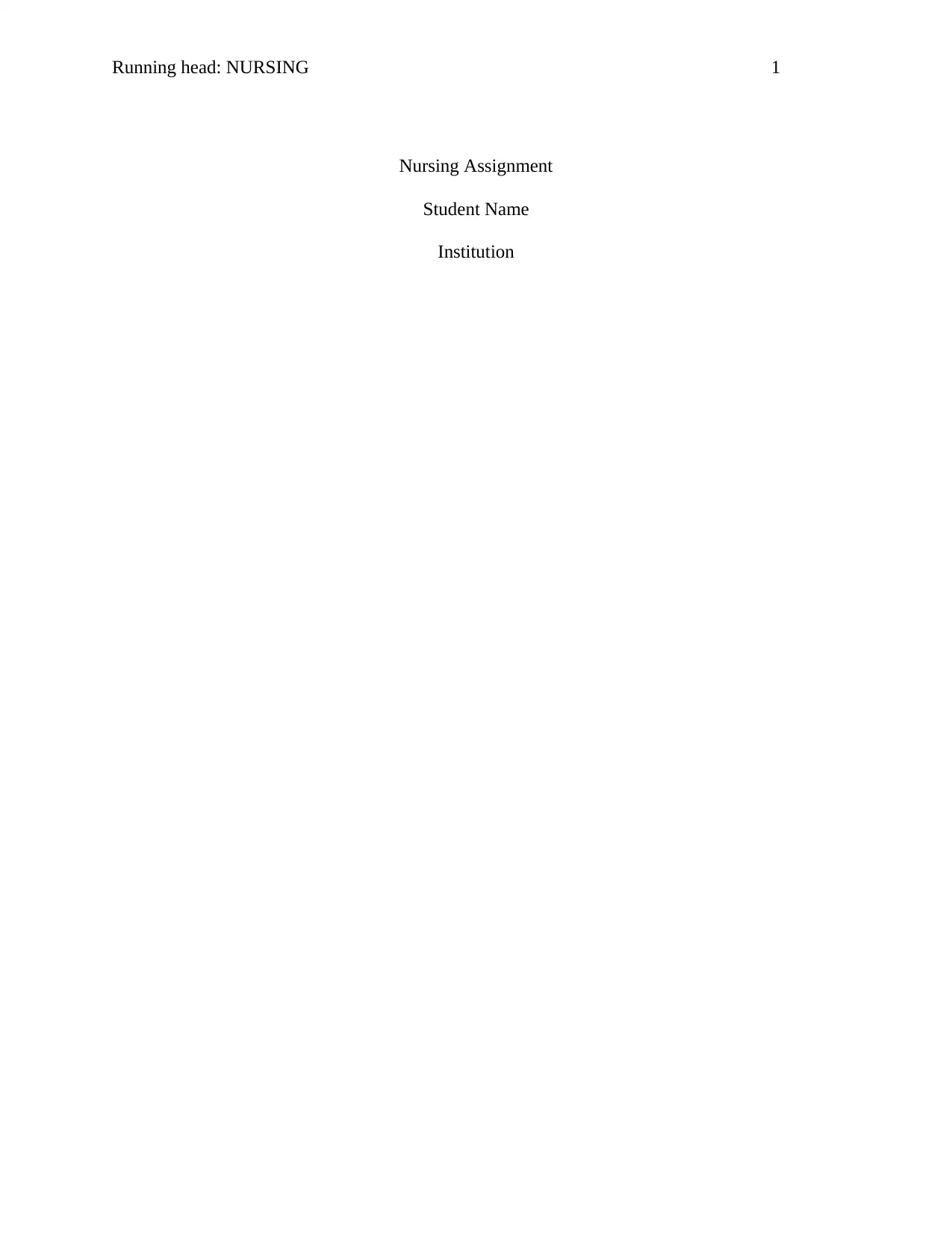
Running head: NURSING 1
Nursing Assignment
Student Name
Institution
Nursing Assignment
Student Name
Institution
Paraphrase This Document
Need a fresh take? Get an instant paraphrase of this document with our AI Paraphraser
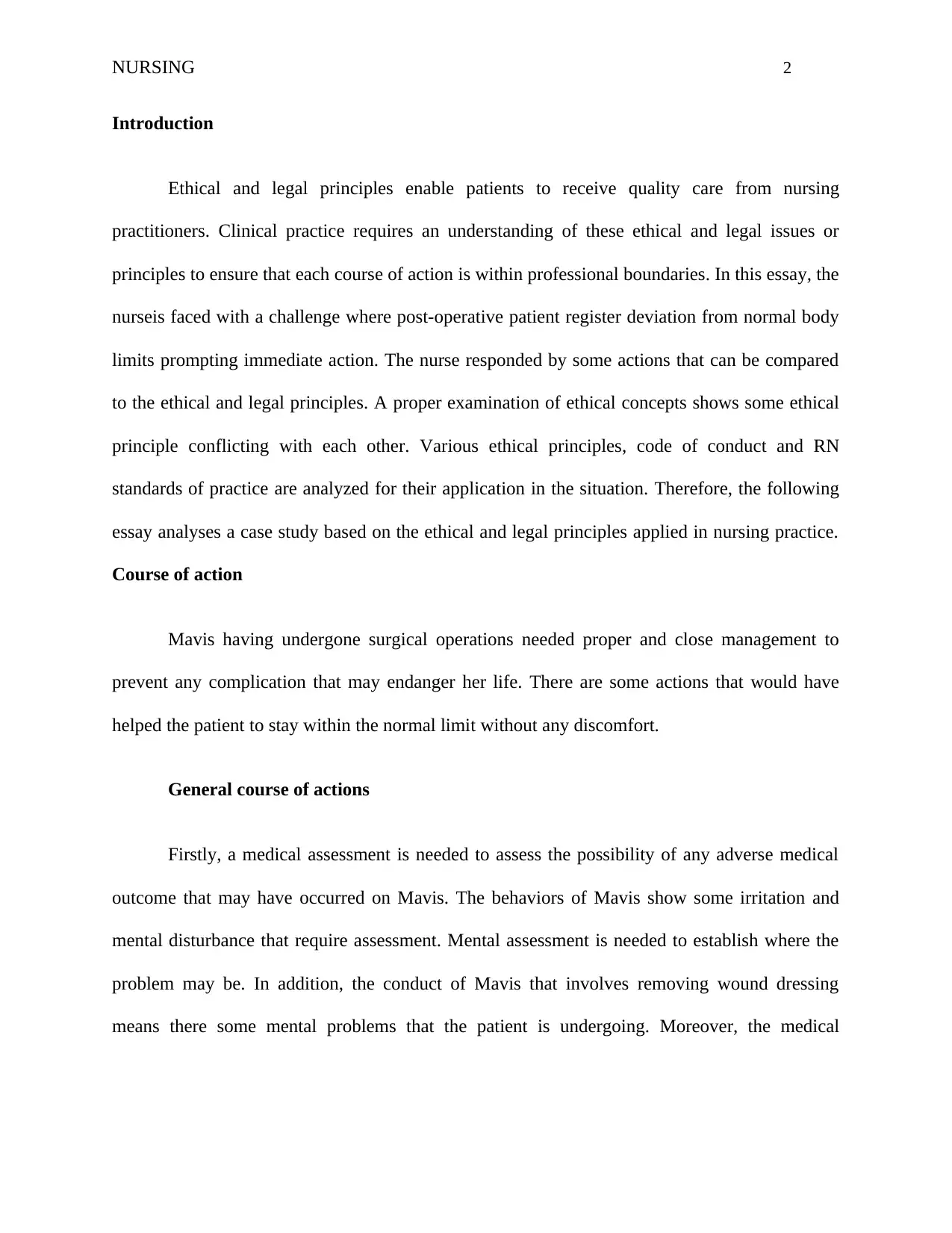
NURSING 2
Introduction
Ethical and legal principles enable patients to receive quality care from nursing
practitioners. Clinical practice requires an understanding of these ethical and legal issues or
principles to ensure that each course of action is within professional boundaries. In this essay, the
nurseis faced with a challenge where post-operative patient register deviation from normal body
limits prompting immediate action. The nurse responded by some actions that can be compared
to the ethical and legal principles. A proper examination of ethical concepts shows some ethical
principle conflicting with each other. Various ethical principles, code of conduct and RN
standards of practice are analyzed for their application in the situation. Therefore, the following
essay analyses a case study based on the ethical and legal principles applied in nursing practice.
Course of action
Mavis having undergone surgical operations needed proper and close management to
prevent any complication that may endanger her life. There are some actions that would have
helped the patient to stay within the normal limit without any discomfort.
General course of actions
Firstly, a medical assessment is needed to assess the possibility of any adverse medical
outcome that may have occurred on Mavis. The behaviors of Mavis show some irritation and
mental disturbance that require assessment. Mental assessment is needed to establish where the
problem may be. In addition, the conduct of Mavis that involves removing wound dressing
means there some mental problems that the patient is undergoing. Moreover, the medical
Introduction
Ethical and legal principles enable patients to receive quality care from nursing
practitioners. Clinical practice requires an understanding of these ethical and legal issues or
principles to ensure that each course of action is within professional boundaries. In this essay, the
nurseis faced with a challenge where post-operative patient register deviation from normal body
limits prompting immediate action. The nurse responded by some actions that can be compared
to the ethical and legal principles. A proper examination of ethical concepts shows some ethical
principle conflicting with each other. Various ethical principles, code of conduct and RN
standards of practice are analyzed for their application in the situation. Therefore, the following
essay analyses a case study based on the ethical and legal principles applied in nursing practice.
Course of action
Mavis having undergone surgical operations needed proper and close management to
prevent any complication that may endanger her life. There are some actions that would have
helped the patient to stay within the normal limit without any discomfort.
General course of actions
Firstly, a medical assessment is needed to assess the possibility of any adverse medical
outcome that may have occurred on Mavis. The behaviors of Mavis show some irritation and
mental disturbance that require assessment. Mental assessment is needed to establish where the
problem may be. In addition, the conduct of Mavis that involves removing wound dressing
means there some mental problems that the patient is undergoing. Moreover, the medical
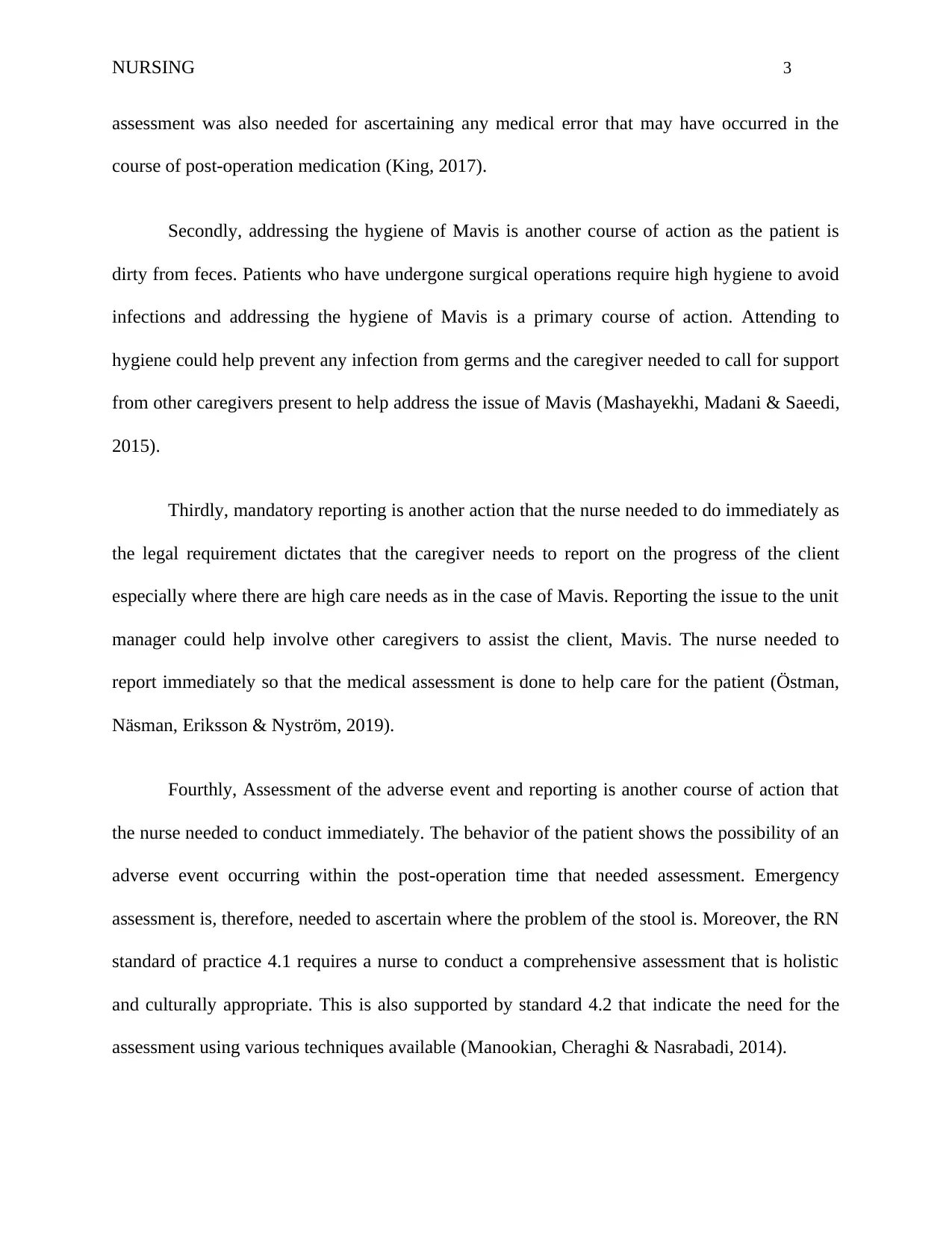
NURSING 3
assessment was also needed for ascertaining any medical error that may have occurred in the
course of post-operation medication (King, 2017).
Secondly, addressing the hygiene of Mavis is another course of action as the patient is
dirty from feces. Patients who have undergone surgical operations require high hygiene to avoid
infections and addressing the hygiene of Mavis is a primary course of action. Attending to
hygiene could help prevent any infection from germs and the caregiver needed to call for support
from other caregivers present to help address the issue of Mavis (Mashayekhi, Madani & Saeedi,
2015).
Thirdly, mandatory reporting is another action that the nurse needed to do immediately as
the legal requirement dictates that the caregiver needs to report on the progress of the client
especially where there are high care needs as in the case of Mavis. Reporting the issue to the unit
manager could help involve other caregivers to assist the client, Mavis. The nurse needed to
report immediately so that the medical assessment is done to help care for the patient (Östman,
Näsman, Eriksson & Nyström, 2019).
Fourthly, Assessment of the adverse event and reporting is another course of action that
the nurse needed to conduct immediately. The behavior of the patient shows the possibility of an
adverse event occurring within the post-operation time that needed assessment. Emergency
assessment is, therefore, needed to ascertain where the problem of the stool is. Moreover, the RN
standard of practice 4.1 requires a nurse to conduct a comprehensive assessment that is holistic
and culturally appropriate. This is also supported by standard 4.2 that indicate the need for the
assessment using various techniques available (Manookian, Cheraghi & Nasrabadi, 2014).
assessment was also needed for ascertaining any medical error that may have occurred in the
course of post-operation medication (King, 2017).
Secondly, addressing the hygiene of Mavis is another course of action as the patient is
dirty from feces. Patients who have undergone surgical operations require high hygiene to avoid
infections and addressing the hygiene of Mavis is a primary course of action. Attending to
hygiene could help prevent any infection from germs and the caregiver needed to call for support
from other caregivers present to help address the issue of Mavis (Mashayekhi, Madani & Saeedi,
2015).
Thirdly, mandatory reporting is another action that the nurse needed to do immediately as
the legal requirement dictates that the caregiver needs to report on the progress of the client
especially where there are high care needs as in the case of Mavis. Reporting the issue to the unit
manager could help involve other caregivers to assist the client, Mavis. The nurse needed to
report immediately so that the medical assessment is done to help care for the patient (Östman,
Näsman, Eriksson & Nyström, 2019).
Fourthly, Assessment of the adverse event and reporting is another course of action that
the nurse needed to conduct immediately. The behavior of the patient shows the possibility of an
adverse event occurring within the post-operation time that needed assessment. Emergency
assessment is, therefore, needed to ascertain where the problem of the stool is. Moreover, the RN
standard of practice 4.1 requires a nurse to conduct a comprehensive assessment that is holistic
and culturally appropriate. This is also supported by standard 4.2 that indicate the need for the
assessment using various techniques available (Manookian, Cheraghi & Nasrabadi, 2014).
⊘ This is a preview!⊘
Do you want full access?
Subscribe today to unlock all pages.

Trusted by 1+ million students worldwide
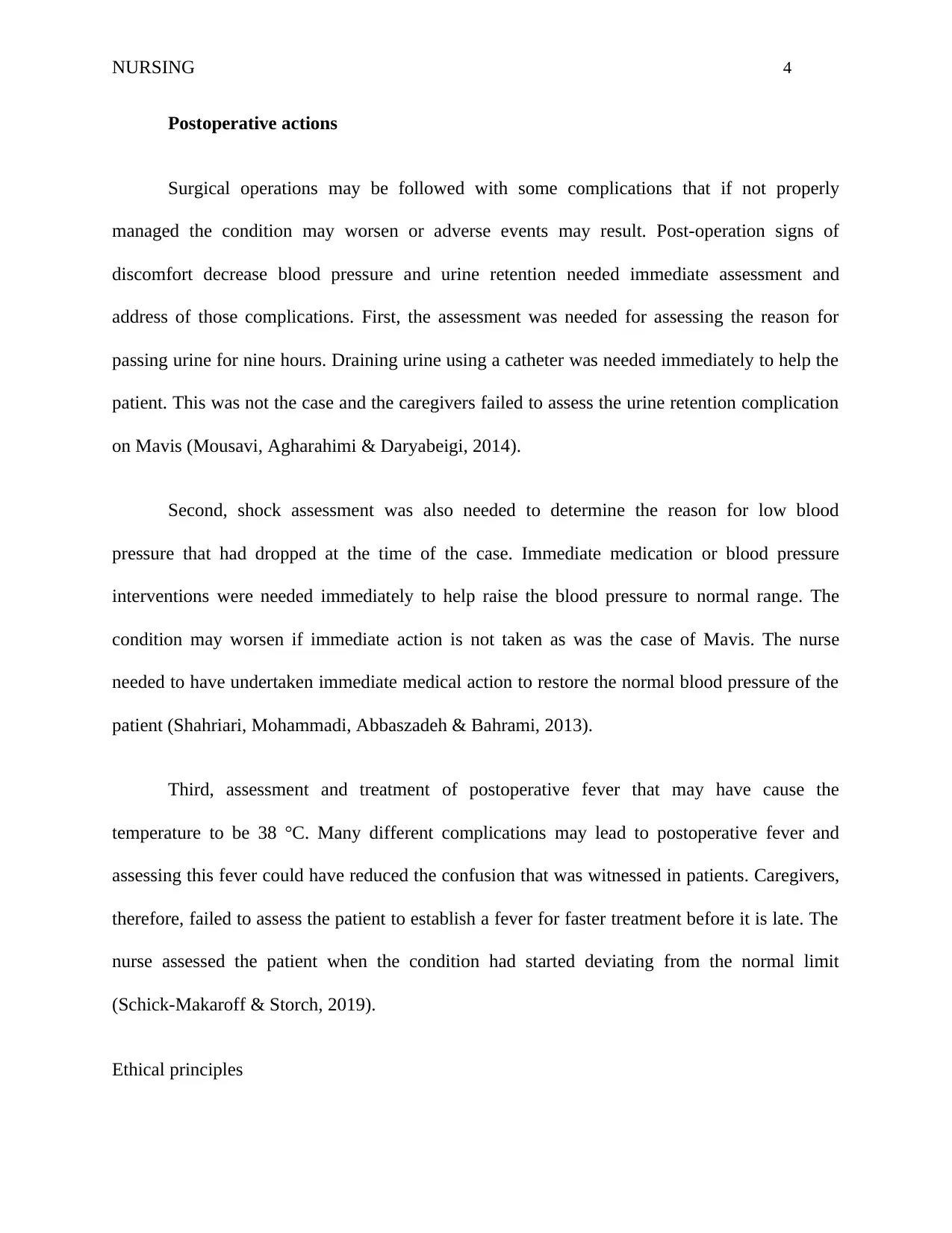
NURSING 4
Postoperative actions
Surgical operations may be followed with some complications that if not properly
managed the condition may worsen or adverse events may result. Post-operation signs of
discomfort decrease blood pressure and urine retention needed immediate assessment and
address of those complications. First, the assessment was needed for assessing the reason for
passing urine for nine hours. Draining urine using a catheter was needed immediately to help the
patient. This was not the case and the caregivers failed to assess the urine retention complication
on Mavis (Mousavi, Agharahimi & Daryabeigi, 2014).
Second, shock assessment was also needed to determine the reason for low blood
pressure that had dropped at the time of the case. Immediate medication or blood pressure
interventions were needed immediately to help raise the blood pressure to normal range. The
condition may worsen if immediate action is not taken as was the case of Mavis. The nurse
needed to have undertaken immediate medical action to restore the normal blood pressure of the
patient (Shahriari, Mohammadi, Abbaszadeh & Bahrami, 2013).
Third, assessment and treatment of postoperative fever that may have cause the
temperature to be 38 °C. Many different complications may lead to postoperative fever and
assessing this fever could have reduced the confusion that was witnessed in patients. Caregivers,
therefore, failed to assess the patient to establish a fever for faster treatment before it is late. The
nurse assessed the patient when the condition had started deviating from the normal limit
(Schick-Makaroff & Storch, 2019).
Ethical principles
Postoperative actions
Surgical operations may be followed with some complications that if not properly
managed the condition may worsen or adverse events may result. Post-operation signs of
discomfort decrease blood pressure and urine retention needed immediate assessment and
address of those complications. First, the assessment was needed for assessing the reason for
passing urine for nine hours. Draining urine using a catheter was needed immediately to help the
patient. This was not the case and the caregivers failed to assess the urine retention complication
on Mavis (Mousavi, Agharahimi & Daryabeigi, 2014).
Second, shock assessment was also needed to determine the reason for low blood
pressure that had dropped at the time of the case. Immediate medication or blood pressure
interventions were needed immediately to help raise the blood pressure to normal range. The
condition may worsen if immediate action is not taken as was the case of Mavis. The nurse
needed to have undertaken immediate medical action to restore the normal blood pressure of the
patient (Shahriari, Mohammadi, Abbaszadeh & Bahrami, 2013).
Third, assessment and treatment of postoperative fever that may have cause the
temperature to be 38 °C. Many different complications may lead to postoperative fever and
assessing this fever could have reduced the confusion that was witnessed in patients. Caregivers,
therefore, failed to assess the patient to establish a fever for faster treatment before it is late. The
nurse assessed the patient when the condition had started deviating from the normal limit
(Schick-Makaroff & Storch, 2019).
Ethical principles
Paraphrase This Document
Need a fresh take? Get an instant paraphrase of this document with our AI Paraphraser
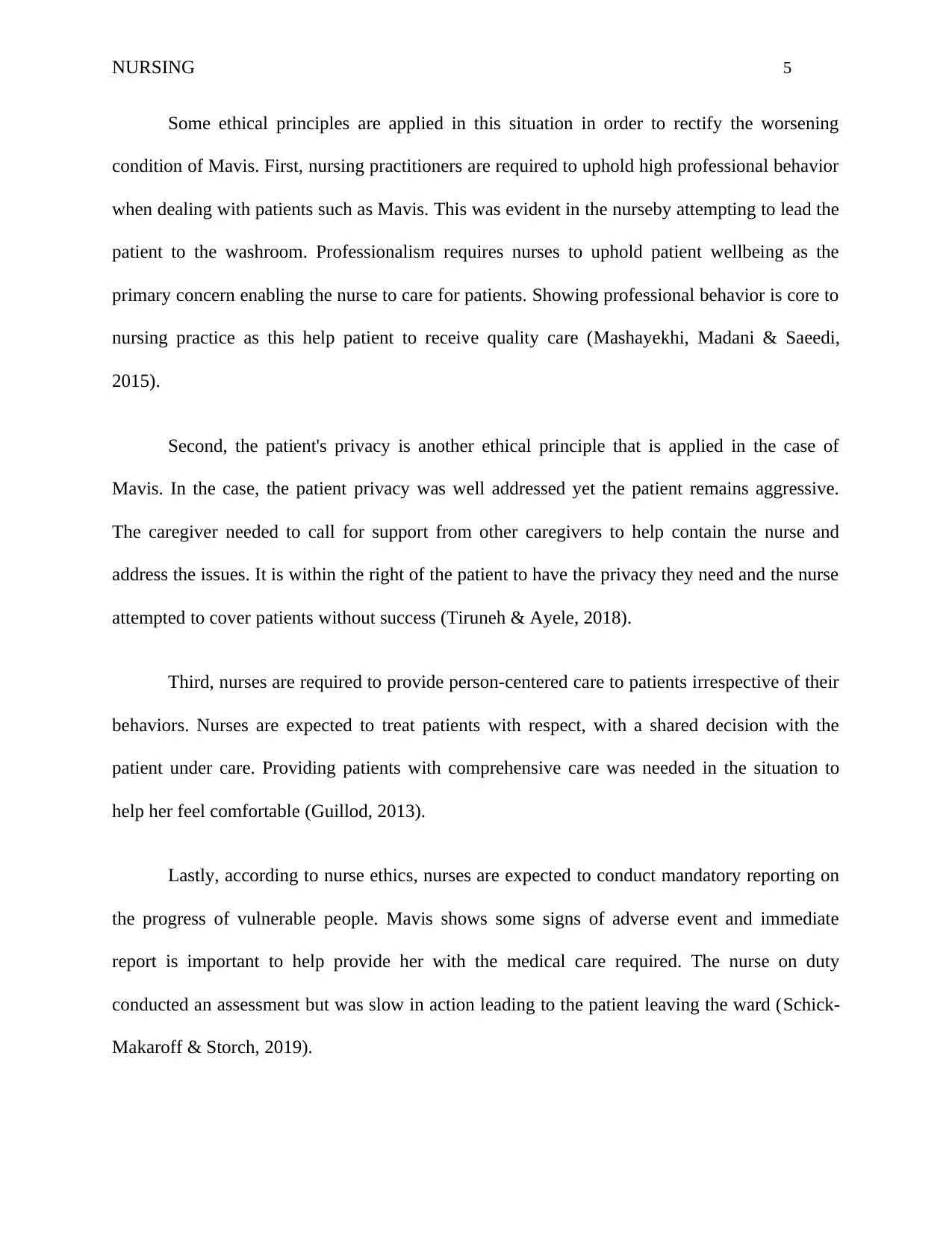
NURSING 5
Some ethical principles are applied in this situation in order to rectify the worsening
condition of Mavis. First, nursing practitioners are required to uphold high professional behavior
when dealing with patients such as Mavis. This was evident in the nurseby attempting to lead the
patient to the washroom. Professionalism requires nurses to uphold patient wellbeing as the
primary concern enabling the nurse to care for patients. Showing professional behavior is core to
nursing practice as this help patient to receive quality care (Mashayekhi, Madani & Saeedi,
2015).
Second, the patient's privacy is another ethical principle that is applied in the case of
Mavis. In the case, the patient privacy was well addressed yet the patient remains aggressive.
The caregiver needed to call for support from other caregivers to help contain the nurse and
address the issues. It is within the right of the patient to have the privacy they need and the nurse
attempted to cover patients without success (Tiruneh & Ayele, 2018).
Third, nurses are required to provide person-centered care to patients irrespective of their
behaviors. Nurses are expected to treat patients with respect, with a shared decision with the
patient under care. Providing patients with comprehensive care was needed in the situation to
help her feel comfortable (Guillod, 2013).
Lastly, according to nurse ethics, nurses are expected to conduct mandatory reporting on
the progress of vulnerable people. Mavis shows some signs of adverse event and immediate
report is important to help provide her with the medical care required. The nurse on duty
conducted an assessment but was slow in action leading to the patient leaving the ward (Schick-
Makaroff & Storch, 2019).
Some ethical principles are applied in this situation in order to rectify the worsening
condition of Mavis. First, nursing practitioners are required to uphold high professional behavior
when dealing with patients such as Mavis. This was evident in the nurseby attempting to lead the
patient to the washroom. Professionalism requires nurses to uphold patient wellbeing as the
primary concern enabling the nurse to care for patients. Showing professional behavior is core to
nursing practice as this help patient to receive quality care (Mashayekhi, Madani & Saeedi,
2015).
Second, the patient's privacy is another ethical principle that is applied in the case of
Mavis. In the case, the patient privacy was well addressed yet the patient remains aggressive.
The caregiver needed to call for support from other caregivers to help contain the nurse and
address the issues. It is within the right of the patient to have the privacy they need and the nurse
attempted to cover patients without success (Tiruneh & Ayele, 2018).
Third, nurses are required to provide person-centered care to patients irrespective of their
behaviors. Nurses are expected to treat patients with respect, with a shared decision with the
patient under care. Providing patients with comprehensive care was needed in the situation to
help her feel comfortable (Guillod, 2013).
Lastly, according to nurse ethics, nurses are expected to conduct mandatory reporting on
the progress of vulnerable people. Mavis shows some signs of adverse event and immediate
report is important to help provide her with the medical care required. The nurse on duty
conducted an assessment but was slow in action leading to the patient leaving the ward (Schick-
Makaroff & Storch, 2019).
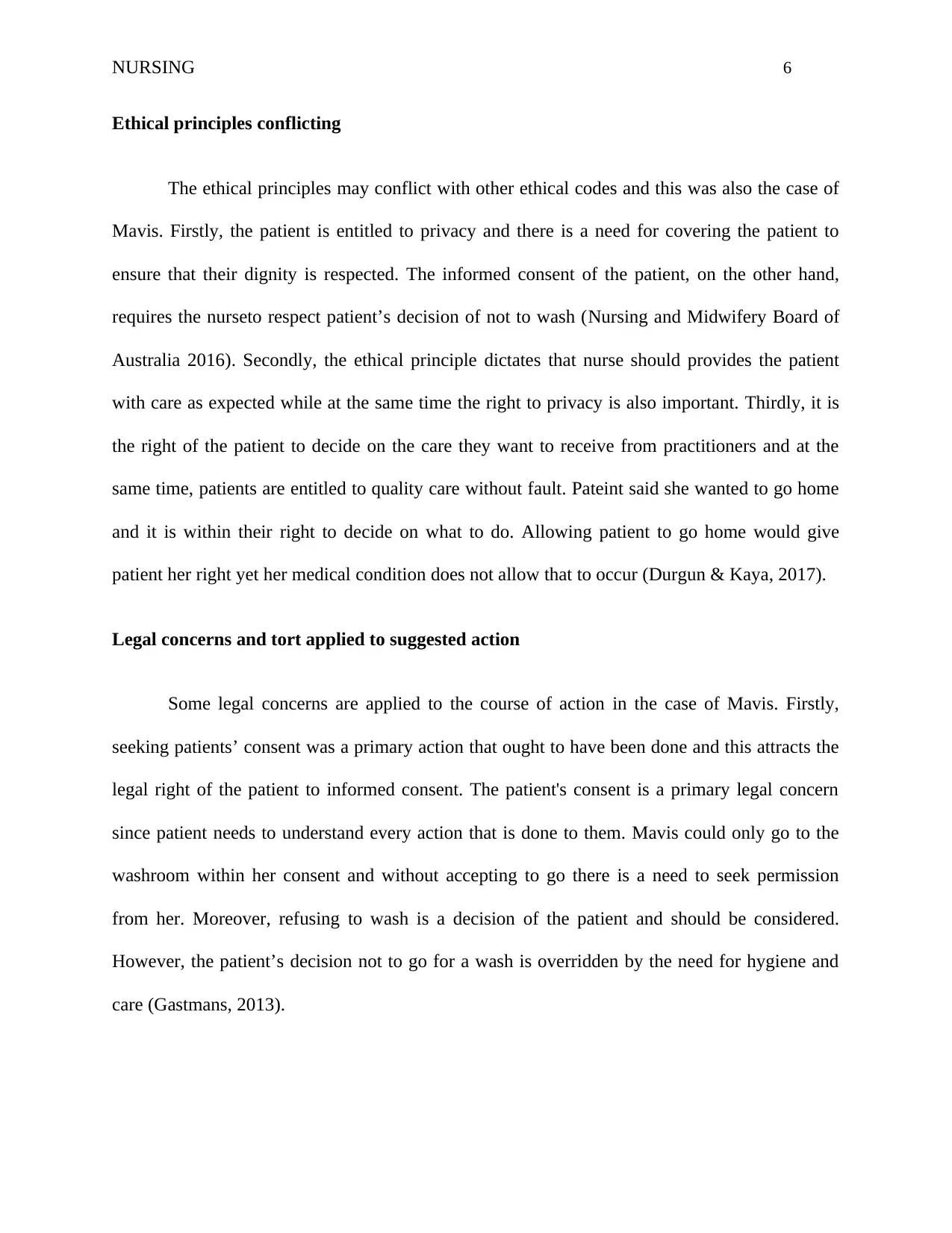
NURSING 6
Ethical principles conflicting
The ethical principles may conflict with other ethical codes and this was also the case of
Mavis. Firstly, the patient is entitled to privacy and there is a need for covering the patient to
ensure that their dignity is respected. The informed consent of the patient, on the other hand,
requires the nurseto respect patient’s decision of not to wash (Nursing and Midwifery Board of
Australia 2016). Secondly, the ethical principle dictates that nurse should provides the patient
with care as expected while at the same time the right to privacy is also important. Thirdly, it is
the right of the patient to decide on the care they want to receive from practitioners and at the
same time, patients are entitled to quality care without fault. Pateint said she wanted to go home
and it is within their right to decide on what to do. Allowing patient to go home would give
patient her right yet her medical condition does not allow that to occur (Durgun & Kaya, 2017).
Legal concerns and tort applied to suggested action
Some legal concerns are applied to the course of action in the case of Mavis. Firstly,
seeking patients’ consent was a primary action that ought to have been done and this attracts the
legal right of the patient to informed consent. The patient's consent is a primary legal concern
since patient needs to understand every action that is done to them. Mavis could only go to the
washroom within her consent and without accepting to go there is a need to seek permission
from her. Moreover, refusing to wash is a decision of the patient and should be considered.
However, the patient’s decision not to go for a wash is overridden by the need for hygiene and
care (Gastmans, 2013).
Ethical principles conflicting
The ethical principles may conflict with other ethical codes and this was also the case of
Mavis. Firstly, the patient is entitled to privacy and there is a need for covering the patient to
ensure that their dignity is respected. The informed consent of the patient, on the other hand,
requires the nurseto respect patient’s decision of not to wash (Nursing and Midwifery Board of
Australia 2016). Secondly, the ethical principle dictates that nurse should provides the patient
with care as expected while at the same time the right to privacy is also important. Thirdly, it is
the right of the patient to decide on the care they want to receive from practitioners and at the
same time, patients are entitled to quality care without fault. Pateint said she wanted to go home
and it is within their right to decide on what to do. Allowing patient to go home would give
patient her right yet her medical condition does not allow that to occur (Durgun & Kaya, 2017).
Legal concerns and tort applied to suggested action
Some legal concerns are applied to the course of action in the case of Mavis. Firstly,
seeking patients’ consent was a primary action that ought to have been done and this attracts the
legal right of the patient to informed consent. The patient's consent is a primary legal concern
since patient needs to understand every action that is done to them. Mavis could only go to the
washroom within her consent and without accepting to go there is a need to seek permission
from her. Moreover, refusing to wash is a decision of the patient and should be considered.
However, the patient’s decision not to go for a wash is overridden by the need for hygiene and
care (Gastmans, 2013).
⊘ This is a preview!⊘
Do you want full access?
Subscribe today to unlock all pages.

Trusted by 1+ million students worldwide
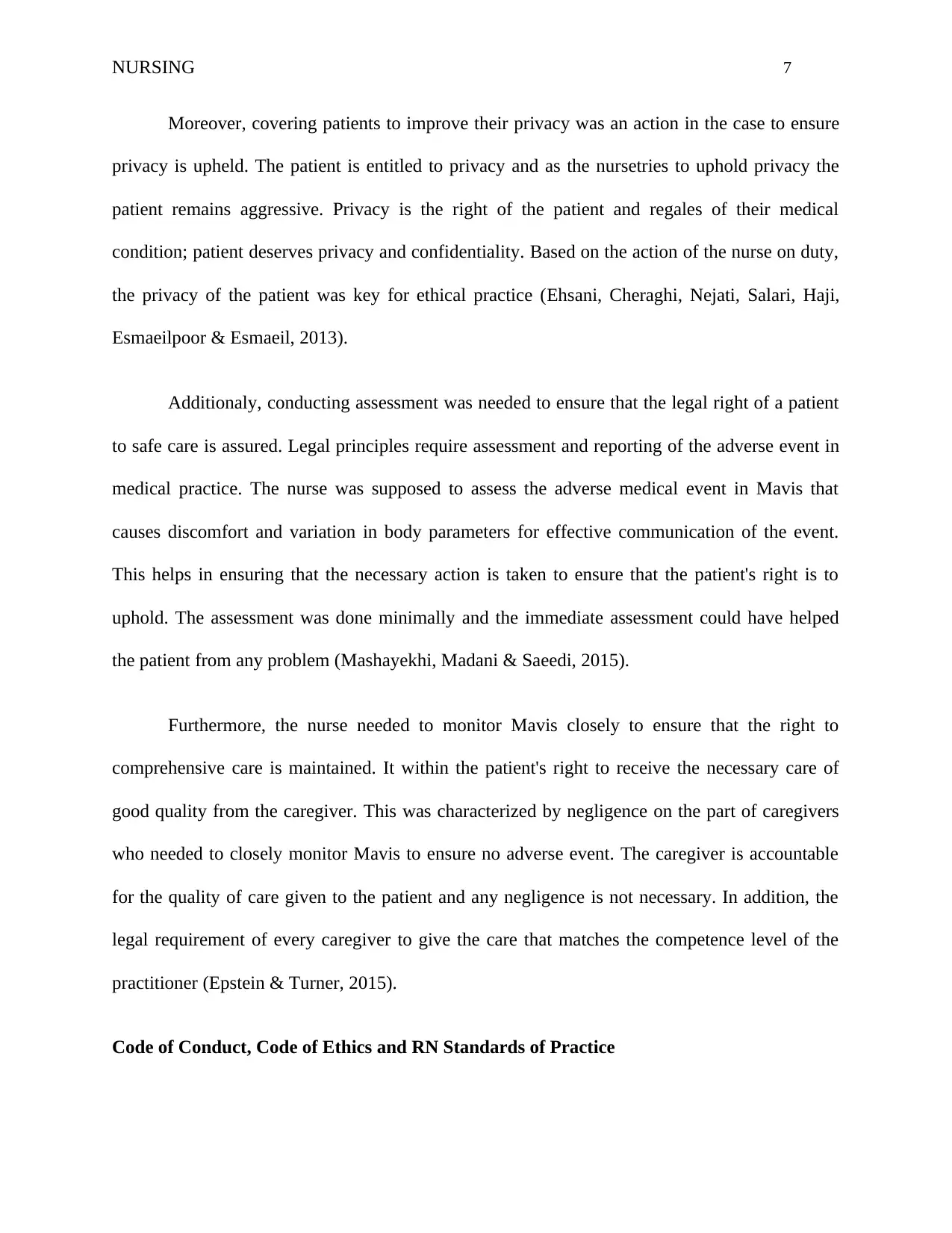
NURSING 7
Moreover, covering patients to improve their privacy was an action in the case to ensure
privacy is upheld. The patient is entitled to privacy and as the nursetries to uphold privacy the
patient remains aggressive. Privacy is the right of the patient and regales of their medical
condition; patient deserves privacy and confidentiality. Based on the action of the nurse on duty,
the privacy of the patient was key for ethical practice (Ehsani, Cheraghi, Nejati, Salari, Haji,
Esmaeilpoor & Esmaeil, 2013).
Additionaly, conducting assessment was needed to ensure that the legal right of a patient
to safe care is assured. Legal principles require assessment and reporting of the adverse event in
medical practice. The nurse was supposed to assess the adverse medical event in Mavis that
causes discomfort and variation in body parameters for effective communication of the event.
This helps in ensuring that the necessary action is taken to ensure that the patient's right is to
uphold. The assessment was done minimally and the immediate assessment could have helped
the patient from any problem (Mashayekhi, Madani & Saeedi, 2015).
Furthermore, the nurse needed to monitor Mavis closely to ensure that the right to
comprehensive care is maintained. It within the patient's right to receive the necessary care of
good quality from the caregiver. This was characterized by negligence on the part of caregivers
who needed to closely monitor Mavis to ensure no adverse event. The caregiver is accountable
for the quality of care given to the patient and any negligence is not necessary. In addition, the
legal requirement of every caregiver to give the care that matches the competence level of the
practitioner (Epstein & Turner, 2015).
Code of Conduct, Code of Ethics and RN Standards of Practice
Moreover, covering patients to improve their privacy was an action in the case to ensure
privacy is upheld. The patient is entitled to privacy and as the nursetries to uphold privacy the
patient remains aggressive. Privacy is the right of the patient and regales of their medical
condition; patient deserves privacy and confidentiality. Based on the action of the nurse on duty,
the privacy of the patient was key for ethical practice (Ehsani, Cheraghi, Nejati, Salari, Haji,
Esmaeilpoor & Esmaeil, 2013).
Additionaly, conducting assessment was needed to ensure that the legal right of a patient
to safe care is assured. Legal principles require assessment and reporting of the adverse event in
medical practice. The nurse was supposed to assess the adverse medical event in Mavis that
causes discomfort and variation in body parameters for effective communication of the event.
This helps in ensuring that the necessary action is taken to ensure that the patient's right is to
uphold. The assessment was done minimally and the immediate assessment could have helped
the patient from any problem (Mashayekhi, Madani & Saeedi, 2015).
Furthermore, the nurse needed to monitor Mavis closely to ensure that the right to
comprehensive care is maintained. It within the patient's right to receive the necessary care of
good quality from the caregiver. This was characterized by negligence on the part of caregivers
who needed to closely monitor Mavis to ensure no adverse event. The caregiver is accountable
for the quality of care given to the patient and any negligence is not necessary. In addition, the
legal requirement of every caregiver to give the care that matches the competence level of the
practitioner (Epstein & Turner, 2015).
Code of Conduct, Code of Ethics and RN Standards of Practice
Paraphrase This Document
Need a fresh take? Get an instant paraphrase of this document with our AI Paraphraser
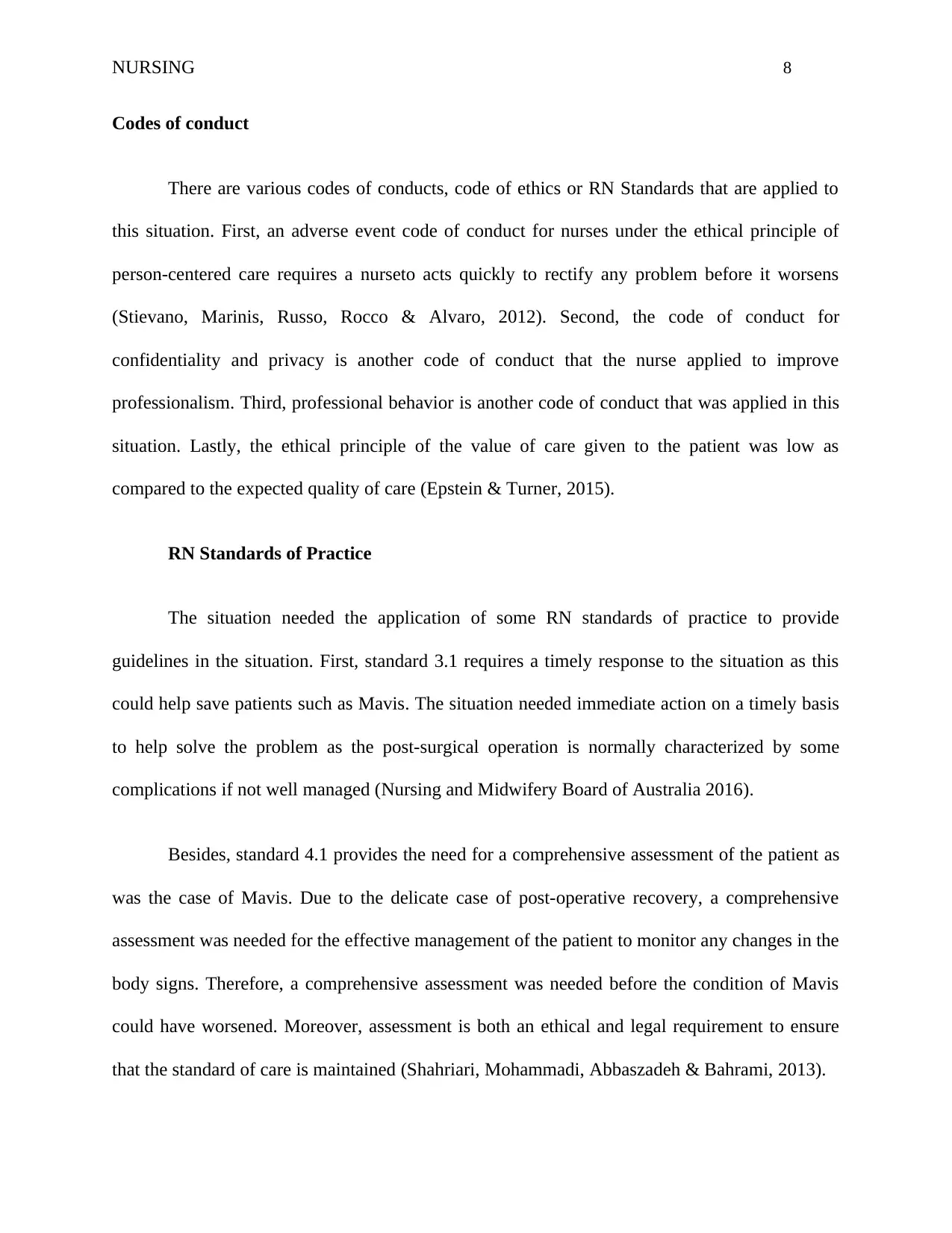
NURSING 8
Codes of conduct
There are various codes of conducts, code of ethics or RN Standards that are applied to
this situation. First, an adverse event code of conduct for nurses under the ethical principle of
person-centered care requires a nurseto acts quickly to rectify any problem before it worsens
(Stievano, Marinis, Russo, Rocco & Alvaro, 2012). Second, the code of conduct for
confidentiality and privacy is another code of conduct that the nurse applied to improve
professionalism. Third, professional behavior is another code of conduct that was applied in this
situation. Lastly, the ethical principle of the value of care given to the patient was low as
compared to the expected quality of care (Epstein & Turner, 2015).
RN Standards of Practice
The situation needed the application of some RN standards of practice to provide
guidelines in the situation. First, standard 3.1 requires a timely response to the situation as this
could help save patients such as Mavis. The situation needed immediate action on a timely basis
to help solve the problem as the post-surgical operation is normally characterized by some
complications if not well managed (Nursing and Midwifery Board of Australia 2016).
Besides, standard 4.1 provides the need for a comprehensive assessment of the patient as
was the case of Mavis. Due to the delicate case of post-operative recovery, a comprehensive
assessment was needed for the effective management of the patient to monitor any changes in the
body signs. Therefore, a comprehensive assessment was needed before the condition of Mavis
could have worsened. Moreover, assessment is both an ethical and legal requirement to ensure
that the standard of care is maintained (Shahriari, Mohammadi, Abbaszadeh & Bahrami, 2013).
Codes of conduct
There are various codes of conducts, code of ethics or RN Standards that are applied to
this situation. First, an adverse event code of conduct for nurses under the ethical principle of
person-centered care requires a nurseto acts quickly to rectify any problem before it worsens
(Stievano, Marinis, Russo, Rocco & Alvaro, 2012). Second, the code of conduct for
confidentiality and privacy is another code of conduct that the nurse applied to improve
professionalism. Third, professional behavior is another code of conduct that was applied in this
situation. Lastly, the ethical principle of the value of care given to the patient was low as
compared to the expected quality of care (Epstein & Turner, 2015).
RN Standards of Practice
The situation needed the application of some RN standards of practice to provide
guidelines in the situation. First, standard 3.1 requires a timely response to the situation as this
could help save patients such as Mavis. The situation needed immediate action on a timely basis
to help solve the problem as the post-surgical operation is normally characterized by some
complications if not well managed (Nursing and Midwifery Board of Australia 2016).
Besides, standard 4.1 provides the need for a comprehensive assessment of the patient as
was the case of Mavis. Due to the delicate case of post-operative recovery, a comprehensive
assessment was needed for the effective management of the patient to monitor any changes in the
body signs. Therefore, a comprehensive assessment was needed before the condition of Mavis
could have worsened. Moreover, assessment is both an ethical and legal requirement to ensure
that the standard of care is maintained (Shahriari, Mohammadi, Abbaszadeh & Bahrami, 2013).
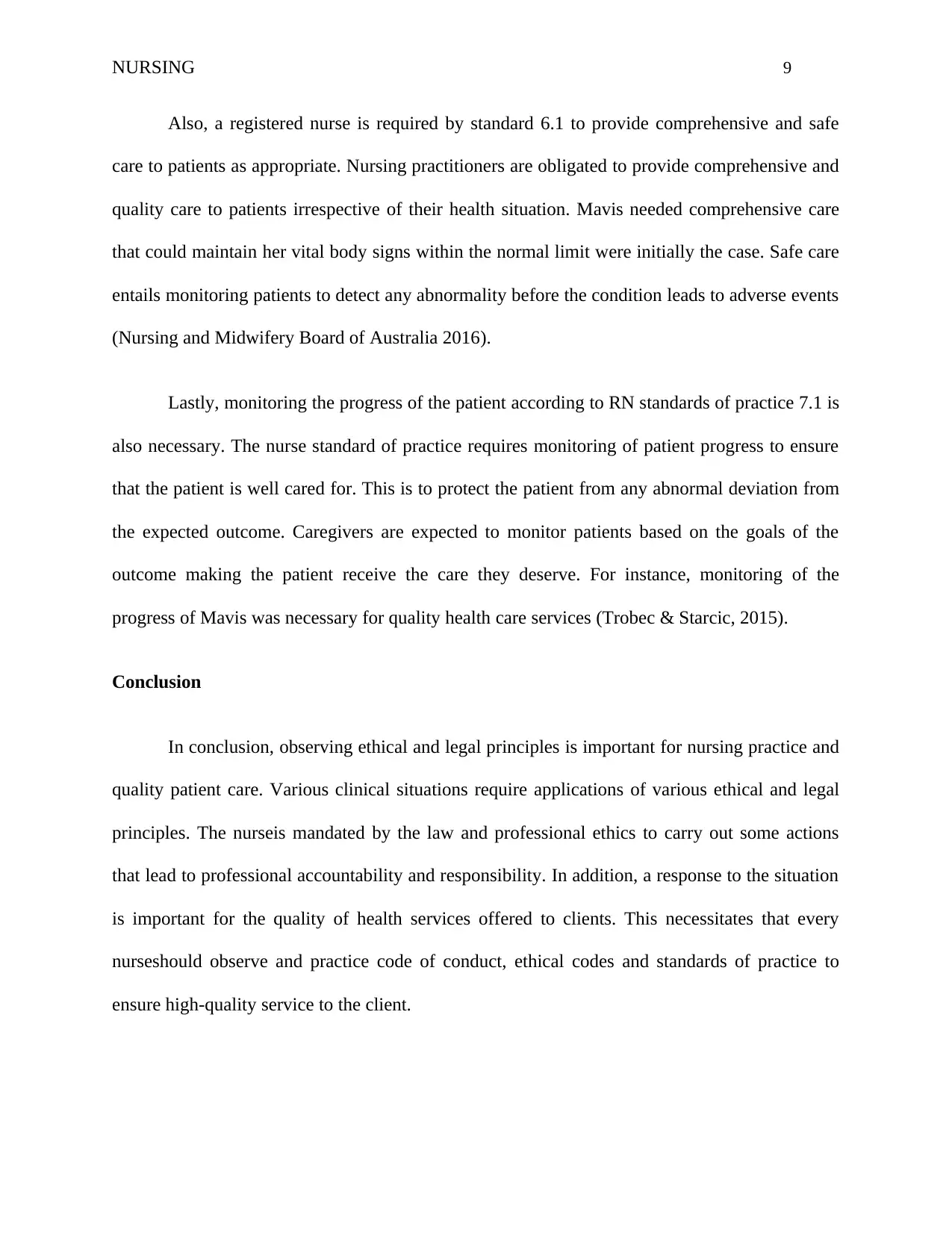
NURSING 9
Also, a registered nurse is required by standard 6.1 to provide comprehensive and safe
care to patients as appropriate. Nursing practitioners are obligated to provide comprehensive and
quality care to patients irrespective of their health situation. Mavis needed comprehensive care
that could maintain her vital body signs within the normal limit were initially the case. Safe care
entails monitoring patients to detect any abnormality before the condition leads to adverse events
(Nursing and Midwifery Board of Australia 2016).
Lastly, monitoring the progress of the patient according to RN standards of practice 7.1 is
also necessary. The nurse standard of practice requires monitoring of patient progress to ensure
that the patient is well cared for. This is to protect the patient from any abnormal deviation from
the expected outcome. Caregivers are expected to monitor patients based on the goals of the
outcome making the patient receive the care they deserve. For instance, monitoring of the
progress of Mavis was necessary for quality health care services (Trobec & Starcic, 2015).
Conclusion
In conclusion, observing ethical and legal principles is important for nursing practice and
quality patient care. Various clinical situations require applications of various ethical and legal
principles. The nurseis mandated by the law and professional ethics to carry out some actions
that lead to professional accountability and responsibility. In addition, a response to the situation
is important for the quality of health services offered to clients. This necessitates that every
nurseshould observe and practice code of conduct, ethical codes and standards of practice to
ensure high-quality service to the client.
Also, a registered nurse is required by standard 6.1 to provide comprehensive and safe
care to patients as appropriate. Nursing practitioners are obligated to provide comprehensive and
quality care to patients irrespective of their health situation. Mavis needed comprehensive care
that could maintain her vital body signs within the normal limit were initially the case. Safe care
entails monitoring patients to detect any abnormality before the condition leads to adverse events
(Nursing and Midwifery Board of Australia 2016).
Lastly, monitoring the progress of the patient according to RN standards of practice 7.1 is
also necessary. The nurse standard of practice requires monitoring of patient progress to ensure
that the patient is well cared for. This is to protect the patient from any abnormal deviation from
the expected outcome. Caregivers are expected to monitor patients based on the goals of the
outcome making the patient receive the care they deserve. For instance, monitoring of the
progress of Mavis was necessary for quality health care services (Trobec & Starcic, 2015).
Conclusion
In conclusion, observing ethical and legal principles is important for nursing practice and
quality patient care. Various clinical situations require applications of various ethical and legal
principles. The nurseis mandated by the law and professional ethics to carry out some actions
that lead to professional accountability and responsibility. In addition, a response to the situation
is important for the quality of health services offered to clients. This necessitates that every
nurseshould observe and practice code of conduct, ethical codes and standards of practice to
ensure high-quality service to the client.
⊘ This is a preview!⊘
Do you want full access?
Subscribe today to unlock all pages.

Trusted by 1+ million students worldwide
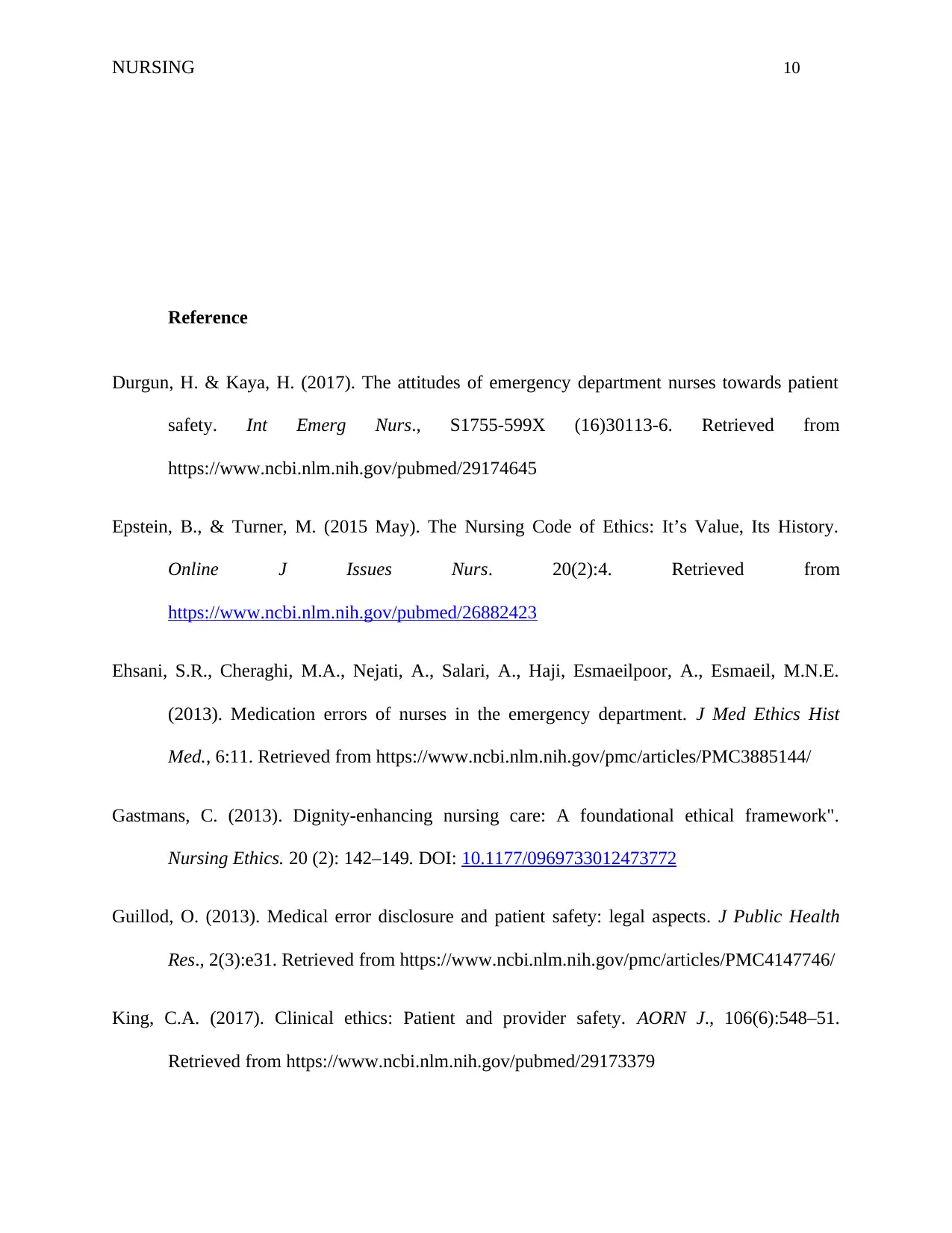
NURSING 10
Reference
Durgun, H. & Kaya, H. (2017). The attitudes of emergency department nurses towards patient
safety. Int Emerg Nurs., S1755-599X (16)30113-6. Retrieved from
https://www.ncbi.nlm.nih.gov/pubmed/29174645
Epstein, B., & Turner, M. (2015 May). The Nursing Code of Ethics: It’s Value, Its History.
Online J Issues Nurs. 20(2):4. Retrieved from
https://www.ncbi.nlm.nih.gov/pubmed/26882423
Ehsani, S.R., Cheraghi, M.A., Nejati, A., Salari, A., Haji, Esmaeilpoor, A., Esmaeil, M.N.E.
(2013). Medication errors of nurses in the emergency department. J Med Ethics Hist
Med., 6:11. Retrieved from https://www.ncbi.nlm.nih.gov/pmc/articles/PMC3885144/
Gastmans, C. (2013). Dignity-enhancing nursing care: A foundational ethical framework".
Nursing Ethics. 20 (2): 142–149. DOI: 10.1177/0969733012473772
Guillod, O. (2013). Medical error disclosure and patient safety: legal aspects. J Public Health
Res., 2(3):e31. Retrieved from https://www.ncbi.nlm.nih.gov/pmc/articles/PMC4147746/
King, C.A. (2017). Clinical ethics: Patient and provider safety. AORN J., 106(6):548–51.
Retrieved from https://www.ncbi.nlm.nih.gov/pubmed/29173379
Reference
Durgun, H. & Kaya, H. (2017). The attitudes of emergency department nurses towards patient
safety. Int Emerg Nurs., S1755-599X (16)30113-6. Retrieved from
https://www.ncbi.nlm.nih.gov/pubmed/29174645
Epstein, B., & Turner, M. (2015 May). The Nursing Code of Ethics: It’s Value, Its History.
Online J Issues Nurs. 20(2):4. Retrieved from
https://www.ncbi.nlm.nih.gov/pubmed/26882423
Ehsani, S.R., Cheraghi, M.A., Nejati, A., Salari, A., Haji, Esmaeilpoor, A., Esmaeil, M.N.E.
(2013). Medication errors of nurses in the emergency department. J Med Ethics Hist
Med., 6:11. Retrieved from https://www.ncbi.nlm.nih.gov/pmc/articles/PMC3885144/
Gastmans, C. (2013). Dignity-enhancing nursing care: A foundational ethical framework".
Nursing Ethics. 20 (2): 142–149. DOI: 10.1177/0969733012473772
Guillod, O. (2013). Medical error disclosure and patient safety: legal aspects. J Public Health
Res., 2(3):e31. Retrieved from https://www.ncbi.nlm.nih.gov/pmc/articles/PMC4147746/
King, C.A. (2017). Clinical ethics: Patient and provider safety. AORN J., 106(6):548–51.
Retrieved from https://www.ncbi.nlm.nih.gov/pubmed/29173379
Paraphrase This Document
Need a fresh take? Get an instant paraphrase of this document with our AI Paraphraser
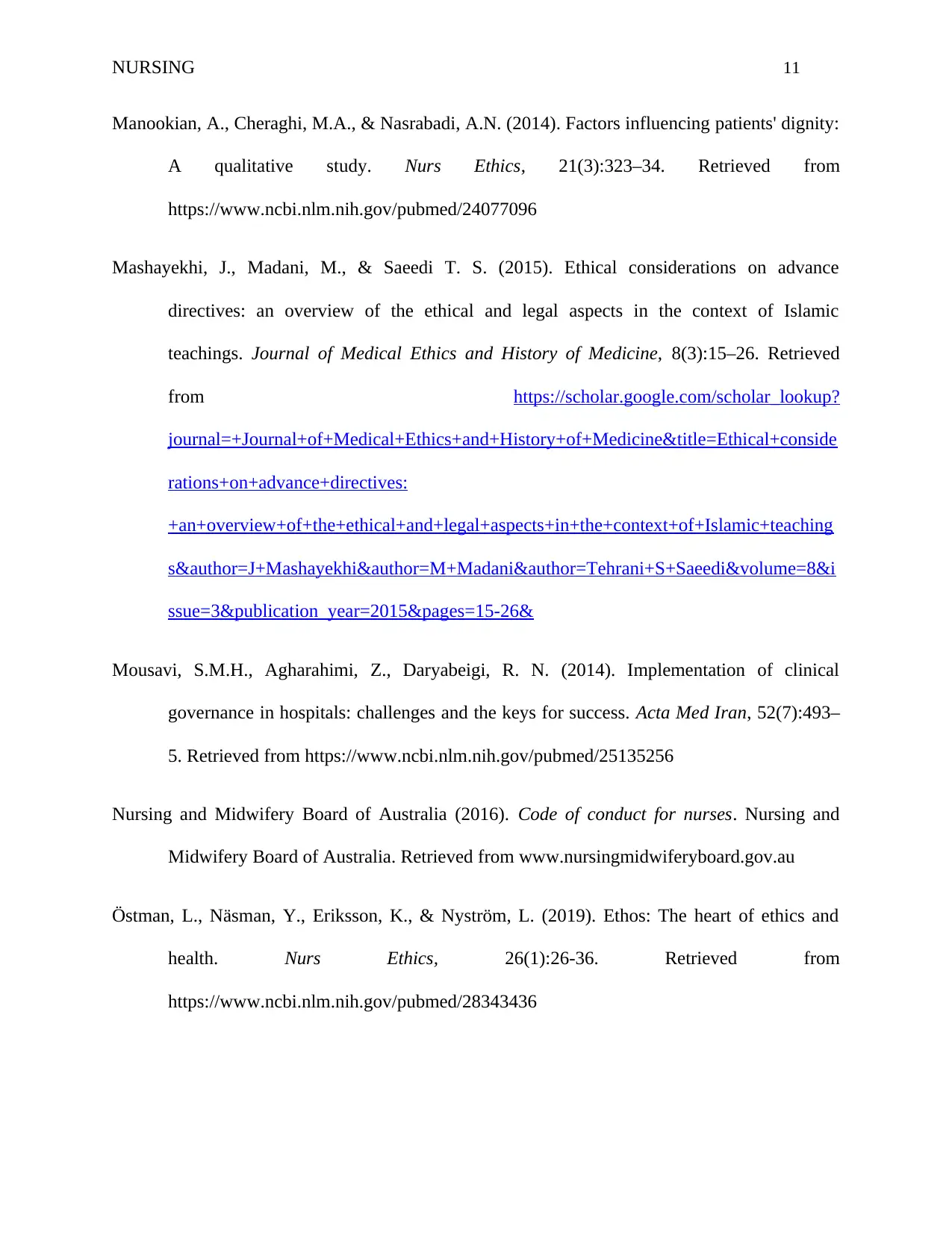
NURSING 11
Manookian, A., Cheraghi, M.A., & Nasrabadi, A.N. (2014). Factors influencing patients' dignity:
A qualitative study. Nurs Ethics, 21(3):323–34. Retrieved from
https://www.ncbi.nlm.nih.gov/pubmed/24077096
Mashayekhi, J., Madani, M., & Saeedi T. S. (2015). Ethical considerations on advance
directives: an overview of the ethical and legal aspects in the context of Islamic
teachings. Journal of Medical Ethics and History of Medicine, 8(3):15–26. Retrieved
from https://scholar.google.com/scholar_lookup?
journal=+Journal+of+Medical+Ethics+and+History+of+Medicine&title=Ethical+conside
rations+on+advance+directives:
+an+overview+of+the+ethical+and+legal+aspects+in+the+context+of+Islamic+teaching
s&author=J+Mashayekhi&author=M+Madani&author=Tehrani+S+Saeedi&volume=8&i
ssue=3&publication_year=2015&pages=15-26&
Mousavi, S.M.H., Agharahimi, Z., Daryabeigi, R. N. (2014). Implementation of clinical
governance in hospitals: challenges and the keys for success. Acta Med Iran, 52(7):493–
5. Retrieved from https://www.ncbi.nlm.nih.gov/pubmed/25135256
Nursing and Midwifery Board of Australia (2016). Code of conduct for nurses. Nursing and
Midwifery Board of Australia. Retrieved from www.nursingmidwiferyboard.gov.au
Östman, L., Näsman, Y., Eriksson, K., & Nyström, L. (2019). Ethos: The heart of ethics and
health. Nurs Ethics, 26(1):26-36. Retrieved from
https://www.ncbi.nlm.nih.gov/pubmed/28343436
Manookian, A., Cheraghi, M.A., & Nasrabadi, A.N. (2014). Factors influencing patients' dignity:
A qualitative study. Nurs Ethics, 21(3):323–34. Retrieved from
https://www.ncbi.nlm.nih.gov/pubmed/24077096
Mashayekhi, J., Madani, M., & Saeedi T. S. (2015). Ethical considerations on advance
directives: an overview of the ethical and legal aspects in the context of Islamic
teachings. Journal of Medical Ethics and History of Medicine, 8(3):15–26. Retrieved
from https://scholar.google.com/scholar_lookup?
journal=+Journal+of+Medical+Ethics+and+History+of+Medicine&title=Ethical+conside
rations+on+advance+directives:
+an+overview+of+the+ethical+and+legal+aspects+in+the+context+of+Islamic+teaching
s&author=J+Mashayekhi&author=M+Madani&author=Tehrani+S+Saeedi&volume=8&i
ssue=3&publication_year=2015&pages=15-26&
Mousavi, S.M.H., Agharahimi, Z., Daryabeigi, R. N. (2014). Implementation of clinical
governance in hospitals: challenges and the keys for success. Acta Med Iran, 52(7):493–
5. Retrieved from https://www.ncbi.nlm.nih.gov/pubmed/25135256
Nursing and Midwifery Board of Australia (2016). Code of conduct for nurses. Nursing and
Midwifery Board of Australia. Retrieved from www.nursingmidwiferyboard.gov.au
Östman, L., Näsman, Y., Eriksson, K., & Nyström, L. (2019). Ethos: The heart of ethics and
health. Nurs Ethics, 26(1):26-36. Retrieved from
https://www.ncbi.nlm.nih.gov/pubmed/28343436
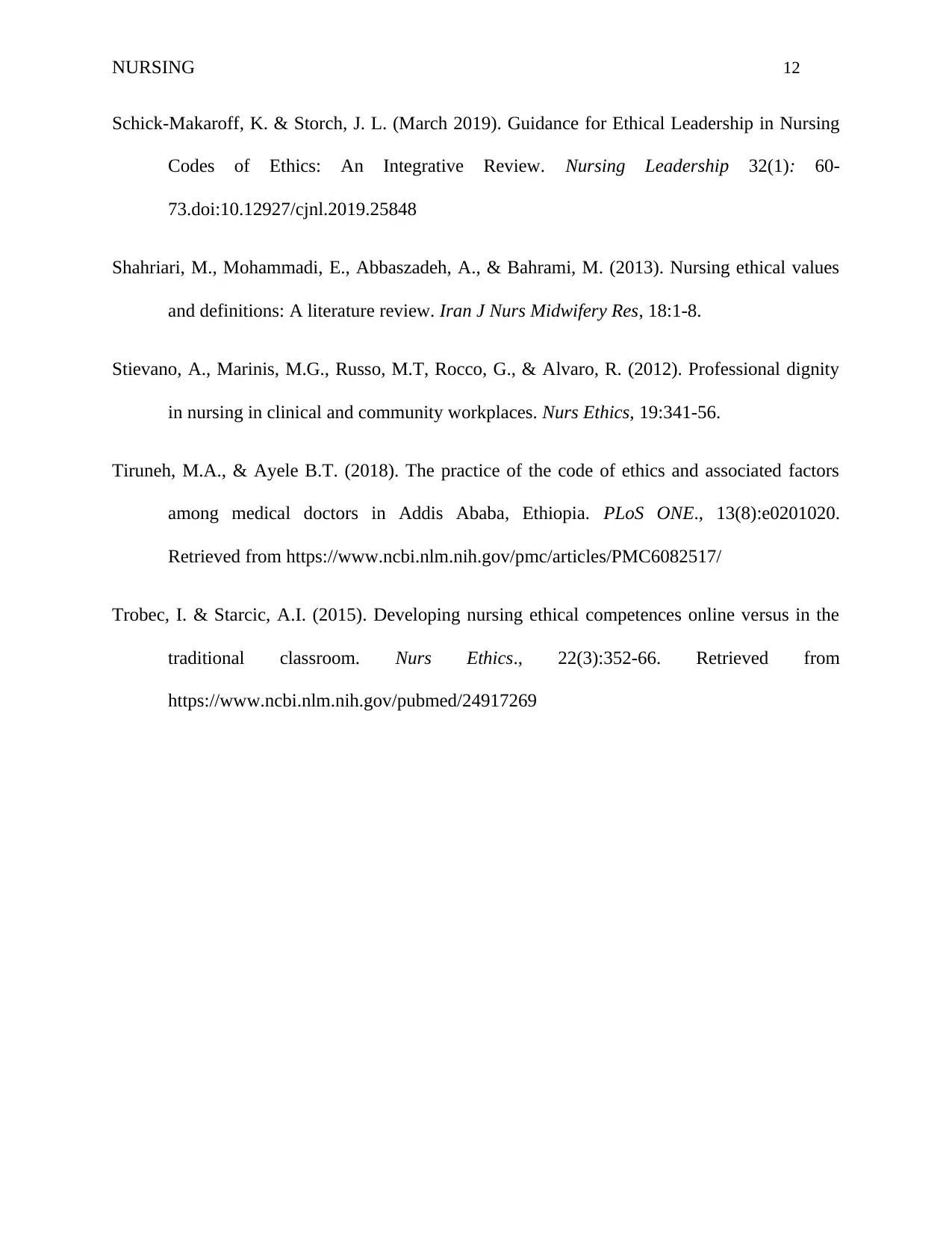
NURSING 12
Schick-Makaroff, K. & Storch, J. L. (March 2019). Guidance for Ethical Leadership in Nursing
Codes of Ethics: An Integrative Review. Nursing Leadership 32(1): 60-
73.doi:10.12927/cjnl.2019.25848
Shahriari, M., Mohammadi, E., Abbaszadeh, A., & Bahrami, M. (2013). Nursing ethical values
and definitions: A literature review. Iran J Nurs Midwifery Res, 18:1-8.
Stievano, A., Marinis, M.G., Russo, M.T, Rocco, G., & Alvaro, R. (2012). Professional dignity
in nursing in clinical and community workplaces. Nurs Ethics, 19:341-56.
Tiruneh, M.A., & Ayele B.T. (2018). The practice of the code of ethics and associated factors
among medical doctors in Addis Ababa, Ethiopia. PLoS ONE., 13(8):e0201020.
Retrieved from https://www.ncbi.nlm.nih.gov/pmc/articles/PMC6082517/
Trobec, I. & Starcic, A.I. (2015). Developing nursing ethical competences online versus in the
traditional classroom. Nurs Ethics., 22(3):352-66. Retrieved from
https://www.ncbi.nlm.nih.gov/pubmed/24917269
Schick-Makaroff, K. & Storch, J. L. (March 2019). Guidance for Ethical Leadership in Nursing
Codes of Ethics: An Integrative Review. Nursing Leadership 32(1): 60-
73.doi:10.12927/cjnl.2019.25848
Shahriari, M., Mohammadi, E., Abbaszadeh, A., & Bahrami, M. (2013). Nursing ethical values
and definitions: A literature review. Iran J Nurs Midwifery Res, 18:1-8.
Stievano, A., Marinis, M.G., Russo, M.T, Rocco, G., & Alvaro, R. (2012). Professional dignity
in nursing in clinical and community workplaces. Nurs Ethics, 19:341-56.
Tiruneh, M.A., & Ayele B.T. (2018). The practice of the code of ethics and associated factors
among medical doctors in Addis Ababa, Ethiopia. PLoS ONE., 13(8):e0201020.
Retrieved from https://www.ncbi.nlm.nih.gov/pmc/articles/PMC6082517/
Trobec, I. & Starcic, A.I. (2015). Developing nursing ethical competences online versus in the
traditional classroom. Nurs Ethics., 22(3):352-66. Retrieved from
https://www.ncbi.nlm.nih.gov/pubmed/24917269
⊘ This is a preview!⊘
Do you want full access?
Subscribe today to unlock all pages.

Trusted by 1+ million students worldwide
1 out of 12
Related Documents
Your All-in-One AI-Powered Toolkit for Academic Success.
+13062052269
info@desklib.com
Available 24*7 on WhatsApp / Email
![[object Object]](/_next/static/media/star-bottom.7253800d.svg)
Unlock your academic potential
Copyright © 2020–2025 A2Z Services. All Rights Reserved. Developed and managed by ZUCOL.





